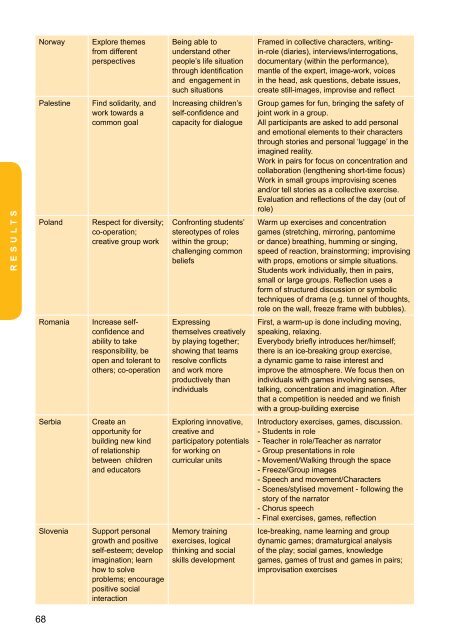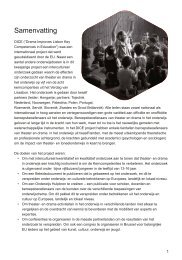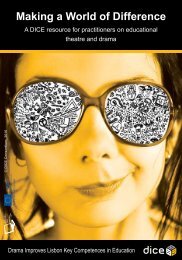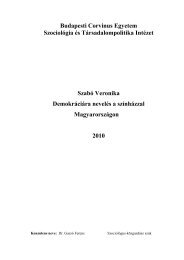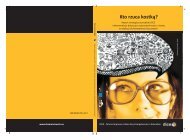Policy Paper - Drama Improves Lisbon Key Competences in Education
Policy Paper - Drama Improves Lisbon Key Competences in Education
Policy Paper - Drama Improves Lisbon Key Competences in Education
Create successful ePaper yourself
Turn your PDF publications into a flip-book with our unique Google optimized e-Paper software.
Norway<br />
Explore themes<br />
from different<br />
perspectives<br />
Be<strong>in</strong>g able to<br />
understand other<br />
people’s life situation<br />
through identification<br />
and engagement <strong>in</strong><br />
such situations<br />
Increas<strong>in</strong>g children’s<br />
self-confidence and<br />
capacity for dialogue<br />
Framed <strong>in</strong> collective characters, writ<strong>in</strong>g<strong>in</strong>-role<br />
(diaries), <strong>in</strong>terviews/<strong>in</strong>terrogations,<br />
documentary (with<strong>in</strong> the performance),<br />
mantle of the expert, image-work, voices<br />
<strong>in</strong> the head, ask questions, debate issues,<br />
create still-images, improvise and reflect<br />
Group games for fun, br<strong>in</strong>g<strong>in</strong>g the safety of<br />
jo<strong>in</strong>t work <strong>in</strong> a group.<br />
All participants are asked to add personal<br />
and emotional elements to their characters<br />
through stories and personal ‘luggage’ <strong>in</strong> the<br />
imag<strong>in</strong>ed reality.<br />
Work <strong>in</strong> pairs for focus on concentration and<br />
collaboration (lengthen<strong>in</strong>g short-time focus)<br />
Work <strong>in</strong> small groups improvis<strong>in</strong>g scenes<br />
and/or tell stories as a collective exercise.<br />
Evaluation and reflections of the day (out of<br />
role)<br />
Warm up exercises and concentration<br />
games (stretch<strong>in</strong>g, mirror<strong>in</strong>g, pantomime<br />
or dance) breath<strong>in</strong>g, humm<strong>in</strong>g or s<strong>in</strong>g<strong>in</strong>g,<br />
speed of reaction, bra<strong>in</strong>storm<strong>in</strong>g; improvis<strong>in</strong>g<br />
with props, emotions or simple situations.<br />
Students work <strong>in</strong>dividually, then <strong>in</strong> pairs,<br />
small or large groups. Reflection uses a<br />
form of structured discussion or symbolic<br />
techniques of drama (e.g. tunnel of thoughts,<br />
role on the wall, freeze frame with bubbles).<br />
First, a warm-up is done <strong>in</strong>clud<strong>in</strong>g mov<strong>in</strong>g,<br />
speak<strong>in</strong>g, relax<strong>in</strong>g.<br />
Everybody briefly <strong>in</strong>troduces her/himself;<br />
there is an ice-break<strong>in</strong>g group exercise,<br />
a dynamic game to raise <strong>in</strong>terest and<br />
improve the atmosphere. We focus then on<br />
<strong>in</strong>dividuals with games <strong>in</strong>volv<strong>in</strong>g senses,<br />
talk<strong>in</strong>g, concentration and imag<strong>in</strong>ation. After<br />
that a competition is needed and we f<strong>in</strong>ish<br />
with a group-build<strong>in</strong>g exercise<br />
Introductory exercises, games, discussion.<br />
- Students <strong>in</strong> role<br />
- Teacher <strong>in</strong> role/Teacher as narrator<br />
- Group presentations <strong>in</strong> role<br />
- Movement/Walk<strong>in</strong>g through the space<br />
- Freeze/Group images<br />
- Speech and movement/Characters<br />
- Scenes/stylised movement - follow<strong>in</strong>g the<br />
story of the narrator<br />
- Chorus speech<br />
- F<strong>in</strong>al exercises, games, reflection<br />
Ice-break<strong>in</strong>g, name learn<strong>in</strong>g and group<br />
dynamic games; dramaturgical analysis<br />
of the play; social games, knowledge<br />
games, games of trust and games <strong>in</strong> pairs;<br />
improvisation exercises<br />
Sweden<br />
Build and establish<br />
trust; sharpen<br />
concentration<br />
Tak<strong>in</strong>g advantage of<br />
<strong>in</strong>dividuals' abilities<br />
and desires and<br />
streng then<strong>in</strong>g them;<br />
build<strong>in</strong>g positive selfconception<br />
Develop<strong>in</strong>g a student’s<br />
‘felt understand<strong>in</strong>g’ of<br />
both themselves and<br />
others with whom they<br />
work<br />
Different games, exercises and warm-ups;<br />
improvisation games/theatre exercises,<br />
movement games, co-exercises and<br />
concentration exercises<br />
R e s u l t s<br />
Palest<strong>in</strong>e<br />
Poland<br />
Romania<br />
Serbia<br />
Slovenia<br />
F<strong>in</strong>d solidarity, and<br />
work towards a<br />
common goal<br />
Respect for diversity;<br />
co-operation;<br />
creative group work<br />
Increase selfconfidence<br />
and<br />
ability to take<br />
responsibility, be<br />
open and tolerant to<br />
others; co-operation<br />
Create an<br />
opportunity for<br />
build<strong>in</strong>g new k<strong>in</strong>d<br />
of relationship<br />
between children<br />
and educators<br />
Support personal<br />
growth and positive<br />
self-esteem; develop<br />
imag<strong>in</strong>ation; learn<br />
how to solve<br />
problems; encourage<br />
positive social<br />
<strong>in</strong>teraction<br />
Confront<strong>in</strong>g students’<br />
stereotypes of roles<br />
with<strong>in</strong> the group;<br />
challeng<strong>in</strong>g common<br />
beliefs<br />
Express<strong>in</strong>g<br />
themselves creatively<br />
by play<strong>in</strong>g together;<br />
show<strong>in</strong>g that teams<br />
resolve conflicts<br />
and work more<br />
productively than<br />
<strong>in</strong>dividuals<br />
Explor<strong>in</strong>g <strong>in</strong>novative,<br />
creative and<br />
participatory potentials<br />
for work<strong>in</strong>g on<br />
curricular units<br />
Memory tra<strong>in</strong><strong>in</strong>g<br />
exercises, logical<br />
th<strong>in</strong>k<strong>in</strong>g and social<br />
skills development<br />
United<br />
K<strong>in</strong>gdom<br />
Table 13. Specific examples of ma<strong>in</strong> aims, focuses and methods of educational theatre and drama work by<br />
country (based on the submitted drama descriptions)<br />
Clusters<br />
Help young people<br />
establish their place<br />
<strong>in</strong> an ever chang<strong>in</strong>g<br />
society through a<br />
creative process<br />
of exploration and<br />
reflection<br />
Aim<br />
Support co-operation, creative group work and work towards a common<br />
goal<br />
Develop communication skills and argumentation techniques and be<br />
open to others’ views<br />
Build social competences, tolerance, empathy, solidarity, encourage<br />
positive social <strong>in</strong>teraction, establish trust among children<br />
Increase self-confidence, self-esteem, support personal growth<br />
Be able to take responsibility, learn how to solve problems, take <strong>in</strong>itiative<br />
Result<br />
Creative, helpful, enthusiastic<br />
co-operators<br />
Effective communicators<br />
‘Agents of hope and change’,<br />
empathic <strong>in</strong>dividuals<br />
People with positive self-image<br />
Initiators, hav<strong>in</strong>g own ideas<br />
All theatre and drama programme leaders were also asked to <strong>in</strong>dicate what the ma<strong>in</strong><br />
purposes of their educational theatre and drama programme were, and to what extent.<br />
Five options with a scale of 1-5 were offered.<br />
If we statistically create groups 55 accord<strong>in</strong>g to which programmes are similar <strong>in</strong> the stated<br />
purposes, we f<strong>in</strong>d four different categories:<br />
Average scores<br />
Cluster 1 2 3 4<br />
14. To create an artistic work 3 1 2 4<br />
15. To develop the social competences of pupils 5 5 5 5<br />
16. To teach pupils about drama 4 2 5 3<br />
17. To learn about a specific theme or topic through drama 5 1 2 3<br />
18. To develop pupils’ creativity and th<strong>in</strong>k<strong>in</strong>g skills 5 5 5 5<br />
Table 15. <strong>Drama</strong> description clusters<br />
The method applies a hybrid of theatre and<br />
drama-<strong>in</strong>-education methodology. The drama<br />
work is designed to work with one class at a<br />
time to maximise the student/actor-teacher<br />
ratio. All the workshop and performance<br />
elements are totally <strong>in</strong>tegrated. The traditional<br />
conventions are associated with the use of<br />
frame, role and task alongside new Bondian<br />
concepts such as the Site, the Centre, the<br />
<strong>Drama</strong> Event and the Invisible Object<br />
Table 14. Ma<strong>in</strong> aims appear<strong>in</strong>g <strong>in</strong> nearly all drama descriptions - and the characteristics of children as described<br />
by educational theatre and drama practitioners themselves<br />
55 This is called “cluster analysis”, See Appendix D3.<br />
R e s u l t s<br />
68<br />
69


